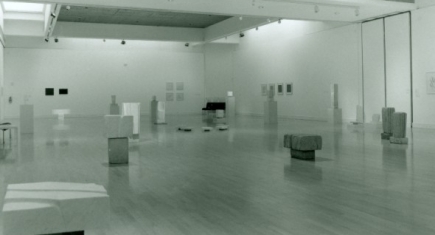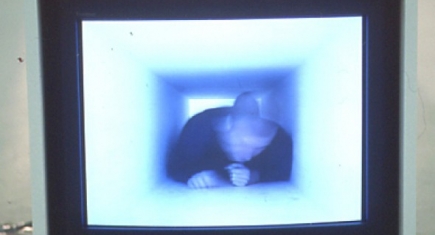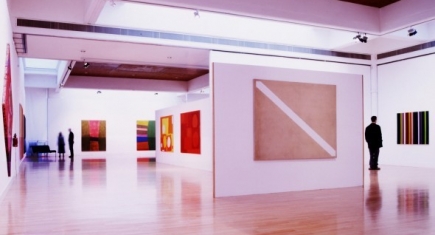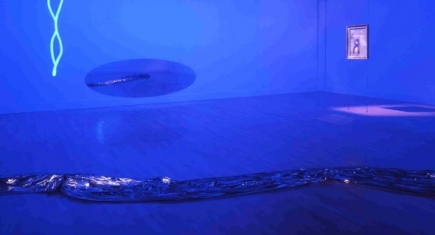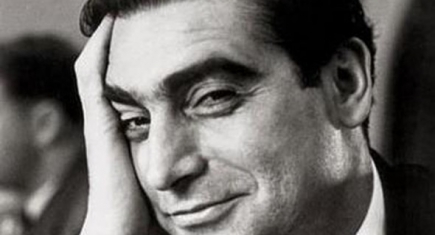Mead Gallery Exhibitions 1999
Kim Lim
Exhibition organised by Camden Arts Centre
Tue 16 Nov – Sat 11 Dec 1999
Kim Lim (1936-1997) is best known for her meditative stone carvings evoking natural forms and rhythms and her concerns with the pulse and vibrancy of organic growth and the movement and reflection of light on water. This exhibition will bring together carved works in marble, granite and Portland stone from the 1980s and 90s. In addition, as selection of prints will show the strong relationship between Lim’s works on paper and in stone.
John Wood and Paul Harrison: Obstacle Course
Film and Video Umbrella touring exhibition in association with firstsite and John Hansard Gallery
Sat 13 Nov – Sat 11 Dec 1999
As the last seconds of the twentieth century tick by, John Wood and Paul Harrison offer an engaging and witty perspective on the scramble towards the millennium. Six video monitors arranged around the gallery offer not so much a view of a race against time but a play in its passing. The video works of these artists are characterised as much by their compositional finesse as by their droll and infectious humour.
The exhibition is supported by Arts Council England. Production supported in part by West Midlands Arts, Video post-production supported by Lighthouse, Wolverhampton
Simulacra: Keeping it Real
A Mead Gallery Exhibition with the Arts Council Collection
Thu 14 Oct – Sat 6 Nov 1999
Simulacra examines the work of a generation of artists born in the 1960s. The established art practice of that period was dominated by American influenced abstract painting, seen in the exhibition in the adjacent galleries. Some thirty years later, artists such as Christine Borland, Damien Hirst and Tania Kovats are international figures themselves. Their work is overtly thoughtful and draws on the day-to-day environment experienced by the viewer.
Different Places: 1960s Abstract Painting and the University
A Mead Gallery Exhibition with the Arts Council Collection
Sat 2 Oct – Sat 6 Nov 1999
In 1965, the University of Warwick bought large, contemporary abstract paintings for its foyers, corridors and teaching rooms. In ‘Different Place’s, these works are now presented in the Mead Gallery in juxtaposition with kindred paintings from the Arts Council Collection. The exhibition will allow visitors to experience these paintings as colour fields, an experiential way of understanding these huge works.
The exhibition includes works by Gillian Ayres, Jack Bush, Bernard Cohen, Gene Davies, Patrick Heron, Tess Jaray, John Hoyland and William Turnbull.
View R: Works in response to the Rugby Collection by David Ward, Hermione Wiltshire and Daphne Wright
A Mead Gallery Exhibition
Fri 30 Apr – Sat 26 Jun 1999
The Rugby Collection includes over 150 works of art by twentieth century artists such as Barbara Hepworth, Leon Kossoff, Paul Nash and Stanley Spencer. The University of Warwick has researched artists and works, published catalogues and commissioned conservation for this outstanding collection since 1986, exhibiting it annually in the Mead Gallery. This year’s major exhibition is in the nature of a farewell as the University says goodbye to the collection. Later this year, it will make its way back to its home town and Rugby’s brand new Art Gallery, currently under construction.
This year’s exhibition celebrates the collection in a unique way. Three artists, David Ward, Hermione Wiltshire and Daphne Wright will transform the gallery with new three dimensional works, made in response to the two dimensional collection of paintings, prints and drawings.
Hermione Wiltshire hopes to create a real sense of anticipation and excitement as the viewer discovers or rediscovers this unique collection. The artist is fascinated by the storage rack in the gallery’s picture store and will relocate it to the gallery. This gives us the first opportunity to present the entire collection – the great works by famous artists and the less successful works by less well known artists. The gallery staff will spend an hour each day, pulling out racks and discussing pictures with visitors.
David Ward’s recent work has explored ideas of reflection and reversal and he is drawn to works in the collection sharing these themes. Central to his installation is Paul Nash’s View R, reunited here with its sister painting by Nash, View from a Window, Nice (View S), on loan from Bradford Museums and Galleries.
Daphne Wright will re-present her exquisite work ‘They’ve Taken To Their Beds’; a huge opulent bower of red roses created in tin foil. Seen alongside selected portraits from the collection, the artist explores ideas of physical appearance and inner self.
Robert Capa: Photographs
Exhibition organised by Aperture, NY
Sat 9 Jan – Sat 10 Mar 1999
This exhibition is the most comprehensive retrospective of Robert Capa’s work to date. Selected by the photographers’ brother Cornell Capa (Founding Director Emeritus of the International Center of Photography in New York) and biographer Richard Whelan, this exhibition is composed of 160 black and white photographs including defining records of the Spanish Civil War, the D-Day landings and the Vietnam War.
Capa constantly risked his own life by working on the front line. Coming ashore with the first wave of American troops in the d-Day landings of 1944, Capa described how ‘the bullets tore holes in the water around me’. For many people, these photograph have come to represent this important event, although their strong sense of movement owes less to ‘ the immense excitement of the moment’, as the magazine Life described it, than to the darkroom worker who turned up the heat in the drying cabinet too high, causing the films to melt.
Yet despite these enormous achievements, Capa cannot solely be categorised as a war photographer. Between assignments, he led a glamorous life and often photographed his celebrity friends. Included in the exhibition is a photograph of Ingrid Bergman on the set of Hitchcock’s ‘Notorious’ – the two year love affair between Bergman and Capa was to inspire ‘Rear Window’ – as well as portraits of Gary Cooper, Hemingway, Steinbeck, Picasso and Matisse.
Mead Gallery Exhibition Guide
ROBERT CAPA (1913 – 1954)
As with many of his equally revolutionary contemporaries, much has already been written about Capa’s life and work. Indeed, his life and work appear inexorably reflexive – his expulsion from Hungary, his time spent studying journalism in Berlin, his fleeing from Hitler’s dictatorship and the death of his lover in the Spanish Civil War. All of this found bizarre bedfellows in the shape of small lightweight cameras and ever improving technology. Parallel to this went a growing profile for photography as a socio-political or fashion vehicle
It remains undeniable, however, that his work is both accessible and challenging in the same instant. This perhaps suggests the kernel of his vision and craft. He made extremely “poetic” images. Those that not only document, reveal and capture a moment in history and peoples’ lives, but also one that for Capa proffers a symbol or parable for the human condition.
What we have before us in this exhibition are opportunities to experience and access a sweeping array of moments. In addition to this social history lesson, we are also provided with comment on each situation through Capa’s artistry. As we progress through the works, we build up not only a wealth of historical and social insight, emphasised by Capa’s pinpointing the precise date of many images, but also a picture of the person who took the shots. His fears, concerns and beliefs slowly emerge before us.
Capa employs key specific repeated vehicles to create his power, voice and poetic language, much as a poet uses repeated words or a painter uses visual motifs. For example, he often uses individuals rather than large anonymous crowds as his windows/narrators on the world. The viewer looks for that individual’s personal story to create meaning and impact – a direct reflection on our own journeys through life.
Another prominent leitmotif, especially in his images of conflicts, is the use of children. The innocent and young being forced to cope with extreme conditions, without perforce comprehending the situation. This throws up the brutality inflicted by war; man’s inhumanity to man.
There are also several images of families and small groups travelling across the frame, often as a direct result of conflict. A pointer to the disruptive forces prevalent in war (e.g. On the road from Namdinh to Thaibinh, May 25, 1954, On the road from Tarragona to Barcelona, January 1939 and Arriving immigrants, Haifa, 1949).
A twist to this theme is his interest in showing humans moving through ruined land and cityscapes. How different we appear when seen against the ravages of warfare! Our own constructed or managed environments cruelly destroyed; rendering progress puny and exposed.(E.g. German farmers fleeing their burning home, near Wesel, March 24, 1945, Agrigento, Sicily, July, 1943 and Men of the U.S. 82nd Airborne Division, St. Sauveur-le-Vicomte, Normandy, June 16, 1944).
Conversely a wry, sanguine humour develops through his shots about the ironies of ruins; particular quirks of accident that see some components of constructions perversely left intact. For example, Stalingrad, August 1947 – the frog fountain and The rusting hulk of the Altalena, Tel Aviv, May 1949). Capa is skilled at holding a mirror up to cause and effect and inviting the viewer to connect the two.
Some of his most abrasive images are those of the dead. They make us feel intrusive, as the subjects were powerless to revoke the camera’s gaze. Yet we are compelled to look. Why? Because despite the abhorrent subject, these remain beautiful images. This is a trait that runs through much of the exhibition – his ability (and compulsion) to make ugly things appear visually arresting.
For example, the parachutist, left exposed and prostrate under his tangled chute and the wires that contributed to his death, takes on a dramatic quality. The chute hangs flaccid and feeble, looking more like a ruched domestic curtain than an instrument of war (American paratroopers near Wesel, March 24, 1945). In contrast, the American soldier, killed by German snipers, Leipzig, April 18, 1945 on the balcony exudes a viscous pool of blood, and on closer inspection we see that rigor mortis has set in. This results in his stiff body remaining arched and tortured. Not even death brought him respite.
And finally the exquisite image of civilians leaning out of windows to watch Chinese fighter planes shoot down Japanese bombers, Hankou, April 29, 1938. The shafts of sunlight breaking between the tree and building imbue the image with magical and romantic overtones. While in reality the people were watching carnage.
This keen sense of injustice saw its conclusive illustration in the manner of Capa’s own death. He stood on a landmine in Vietnam. The last photograph he took before his demise gives us a fair idea of what the scene must have looked like. But how is our reaction altered because we know this was his last shot and we know the manner of his death? His last photograph could almost be termed common place – so used are we to images of war. But we are drawn to it because of its story; a story about an individual who suffered the ultimate indignity of warfare whilst trying to show up its horror.
Not all of the stories and images are so serious though. His portraits give us a very different side to his nature and some hugely different stories. He photographed his friends a lot, and through this gives us a chance to examine what he wanted to say about these people. Despite the eminence of many of his subjects, he appears to reveal their private sides to us through where and how he photographs them. Picasso as the sociable philosopher or surreal exhibitionist, Gary Cooper as the dapper and laid back country gent and John Huston as the consummate Hollywood director. The one thing we can glean from these portraits is that he knew these people and we didn’t. Instead we are offered a new insight into these public figures; a different sort of story.
So Capa offers us both the familiar and the foreign. Think about whether your reactions to his images of unfamiliar countries, costume and landscape actually make you look harder or afresh at the subjects. One almost gets the feeling that he is trying to trip us up at times; perhaps as a way of forcing the viewer to reassess prejudices and misconceptions. Nonetheless throughout his oeuvre what does shine through is his superb ability to expose and highlight human nature.
Jac Wilkinson
December 1998.

